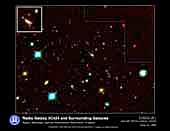Press Release
Radio Galaxy 3C324 with Surrounding Clusters of Galaxies
June 10, 1999
 Low Res. (91 KB) High Res. (386 KB) |
Object: Radio Galaxy 3C324
and Surrounding Clusters of Galaxies Telescope and Focus: Subaru Telescope (Effective diameter 8.2 m), Cassegrain Focus Instrument: CISCO (Cooled Infrared Spectrograph and Camera for OHS) Filter: Near Infrared K'-band (2.15 microns) Colors: red - Subaru Telescope, Near Infrared K'-band (2.15 microns) green- Hubble Space Telescope WFPC2, red visible light (F702W) blue - Hubble Space Telescope WFPC2, blue visible light (F450W) Date of Observation: April 2, 1999 UT. (HST observations are from the STScI archive) Exposure Time: 800 sec Field of View: 1.5 arcmin by 2 arcmin Image Orientation: North is towards upper right (38 degree to the right of vertical); East is towards upper left. Coordinates (J2000.0): RA= 15 h 49 m 48.9 s, DEC= +21 deg 25' 38" |
Explanation:
An active galaxy and clusters of other distant galaxies
are clearly revealed when an infrared image obtained with
the recently completed Subaru Telescope is combined with
Hubble Space Telescope (HST) images taken in visible light.
The small object with tangled red and blue colors near the field center is the active galaxy 3C324. Its enlarged image shown in the inset provides a new view of the galaxy. The active galaxy, emitting strong radio noise, is located 10 billion light years away and displays strong optical jets revealed by Hubble Space Telescope. The inner-most two blue-white "beads" seen in the inset are the two jets of material flowing outward in opposite directions from a central source. Centered on and surrounding the jets is the diffuse reddish glow of the active radio galaxy itself, revealed clearly here by Subaru Telescope. It appears to be an elliptical galaxy. We are seeing this galaxy while it is going through a phase of great activity at a time when the Universe was still very y oung and less than half of its present size.
A dozen red patchy objects seen near the center and to the upper right are members of very distant clusters of galaxies, one of which is thought to be distributed around 3C324. Blue objects are foreground galaxies and stars well detected with Hubble Space Telescope, while the red objects are galaxies barely seen in the visible-light images of Hubble Space Telescope. The tremendous light-gathering power of Subaru Telescope combined with its ability to produce infrared imaging at a resolution approaching that of HST allows us to clearly see sharp and bright details in these faint infrared galaxies. Note that these galaxies appear relatively bright in the infrared because they have long ago finished active star formation (i.e.- now mostly composed of cooler reddish stars) as well as because their starlight is strongly redshifted (z = 1.2) due to the expansion of the Universe.
The resolution of the Subaru Telescope infrared observations used to make this color composite is about 0.36 arcsec. The two HST images used in making this composite originally had a resolution of ~0.15 arcsec and were slightly blurred before combining with the Subaru Telescope image. Also note that the HST data doesn't quite cover the whole image, hence the total lack of blue or green colors in the top right corner (beyond the dotted line).
The HST images were created with the support of the Space Telescope Science Institute, operated by the Association of Universities for Research in Astronomy, Inc., from NASA contract NAS5-26555